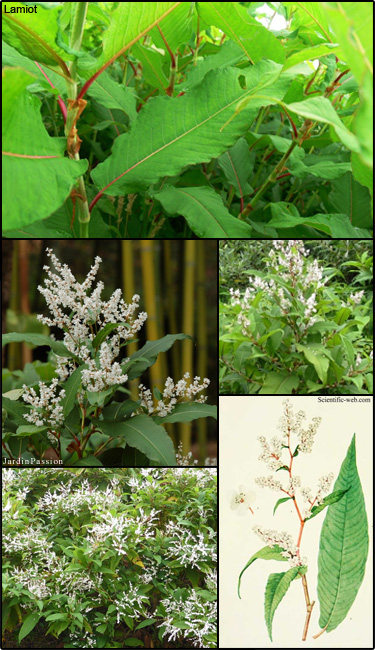Himalayan knotweed (Polygonum polystachyum)
 Synonyms: Aconogonon polystachyum, A. polystachyum, Polygonum polystachyum, Pleuropteropyrum polystachyum, Reynoutria polystachya, Rubrivena polystachya
Synonyms: Aconogonon polystachyum, A. polystachyum, Polygonum polystachyum, Pleuropteropyrum polystachyum, Reynoutria polystachya, Rubrivena polystachyaCommon Names: Cultivated knotweed, Bell-shaped knotweed, Kashmir plume
Description: Can cause photosensitivity in susceptible people. Can reduce availability of nutrients in the soil, competes with trees and can reduce shade along rivers and streams by displacing native, woody species.
Habit: Clumping perennial with large leaves, hollow stems, and long creeping rhizomes. Recognized by its long slender leaves and can grow to 6 feet in height.
Leaves: Alternate, green, lanceolate, 4 to 8 inches long and 1 to 3 inches wide with flat or heart-shaped bases, long-pointed tips and slightly hairy margins. Upper leaf surfaces are glabrous or hairy, and lower leaf surfaces are hairy at least on the margins and veins.
Stems: Numerous, glabrous to densely hairy, ribbed, red-brown in color, erect and branching. Basal leaves are absent. Stipules are fused around the stems to form sheaths that are red-brown, membranous and 1 to 4 cm long.
Flowers: White to pink in color, fragrant, and 3 to 5 mm long. Sepals are oblong to obovate and 2.2 to 3.8 mm long.
Fruit and seeds: Seeds lack wings or keels and are 3-sided, smooth, brown in color, 2.1 to 2.5 mm long, and 1.3 to 1.8 mm wide.
Habitat: Native to Asia. Found on disturbed sites, roadsides, riparian and wetland areas.
Reproduction: Vegetatively from rhizomes and by seed. Each node on the plant stock is able to produce roots and new plants. New plants can sprout from fragments as small as 1 inch.
Similar species: Giant knotweed (Polygonum sachalinensis); Japanese knotweed (Polygonum japonica); Bohemian knotweed (Polygonum xbohemica)
Monitoring and rapid response: Mowing or cutting plant shoots is ineffective alone; however, mowing followed by herbicide treatments will provide some control. Must be repeated if infestation is large. Grubbing out small clumps when discovered can prevent new colonies from establishing. Rhizomes and fragments left in the ground, or nearby, can regenerate. Credits: The information provided in this factsheet was gathered from the University of California: Davis, Washington State Noxious Weed Control Board, and the Alaska Natural Heritage Program: University of Alaska Anchorage.
Individual species images that appear with a number in a black box are courtesy of the Bugwood.org network (http://www.invasive.org).Individual photo author credits may not be included due to the small display size of the images and subsequent difficulty of reading the provided text. All other images appear courtesy of Google (http://images.google.com).
Common Name: | Himalayan knotweed |
Scientific Name: | Polygonum polystachyum |
Family: | Polygonaceae (Buckwheat) |
Duration: | Perennial |
Habit: | Herbs |
USDA Symbol: | POPO5 |
